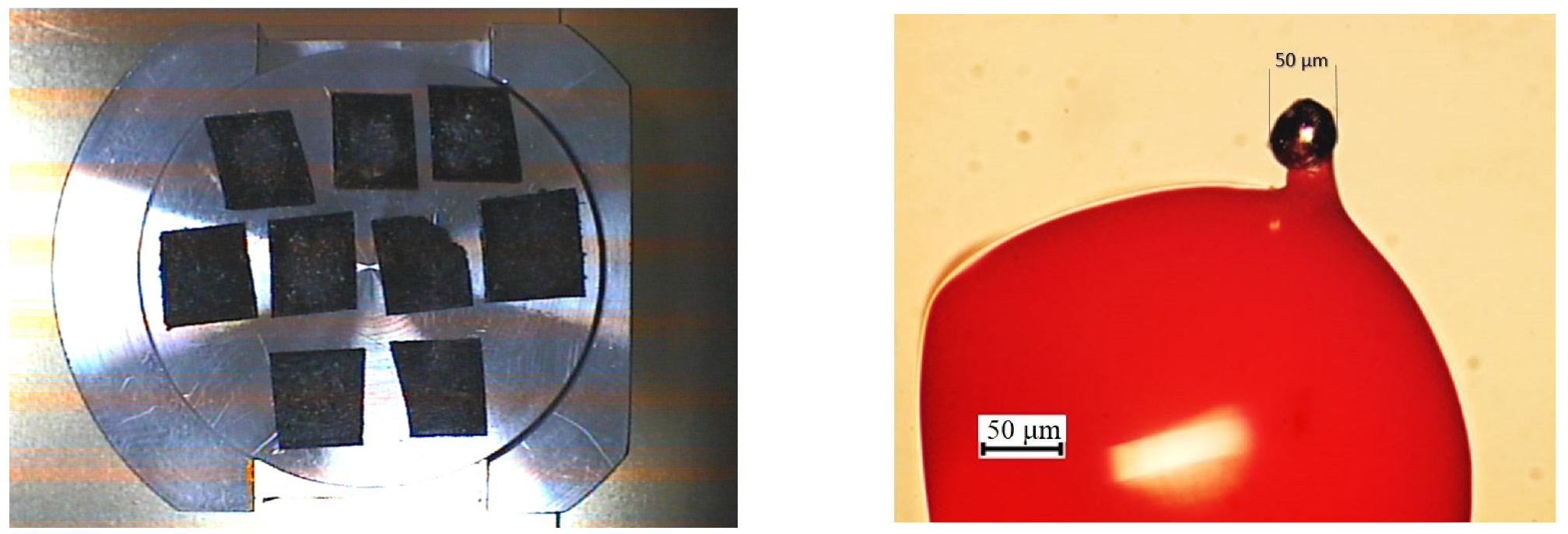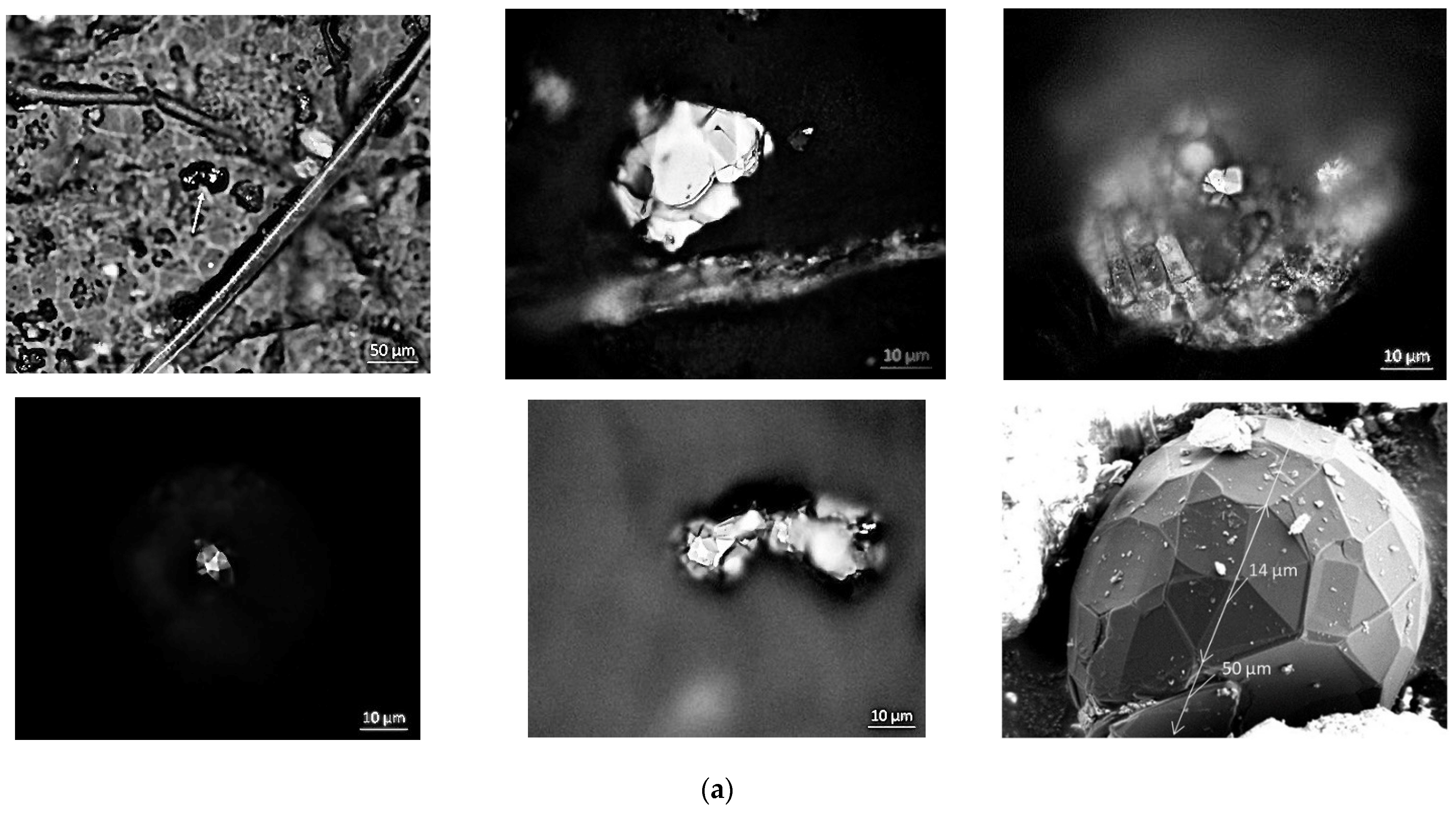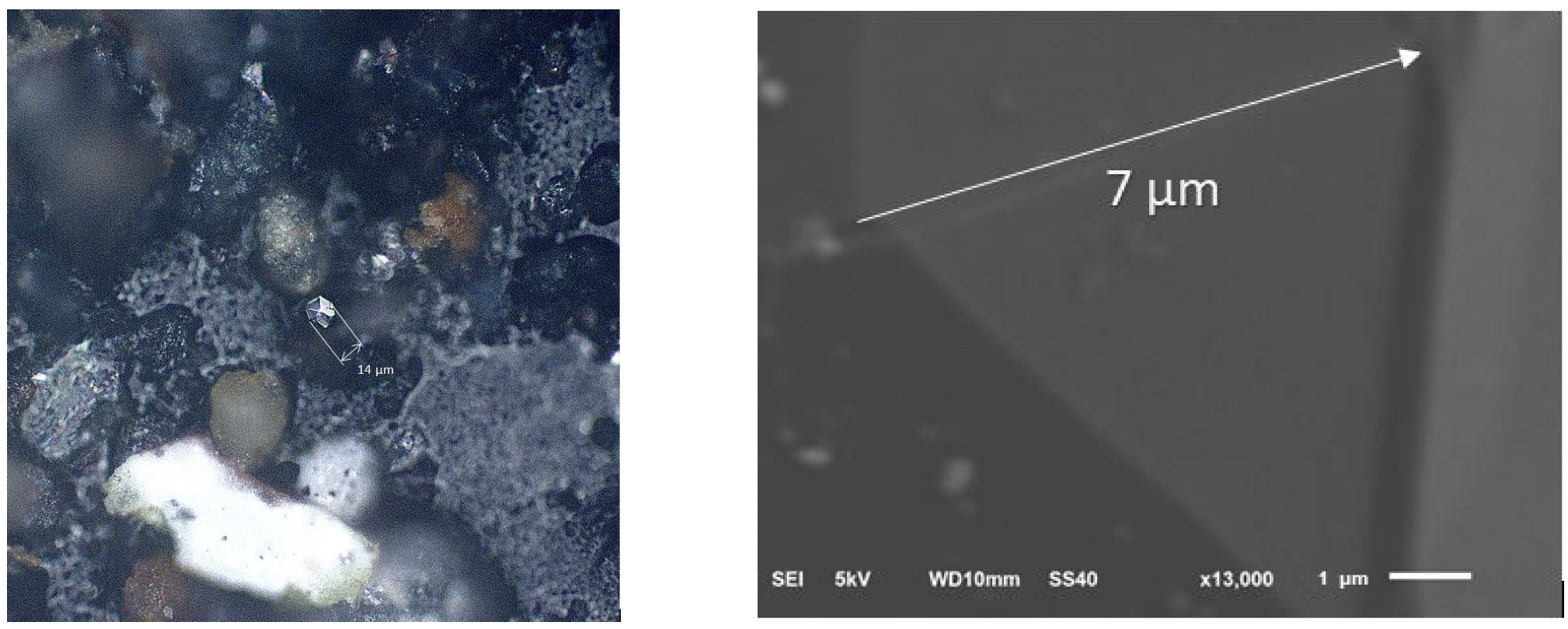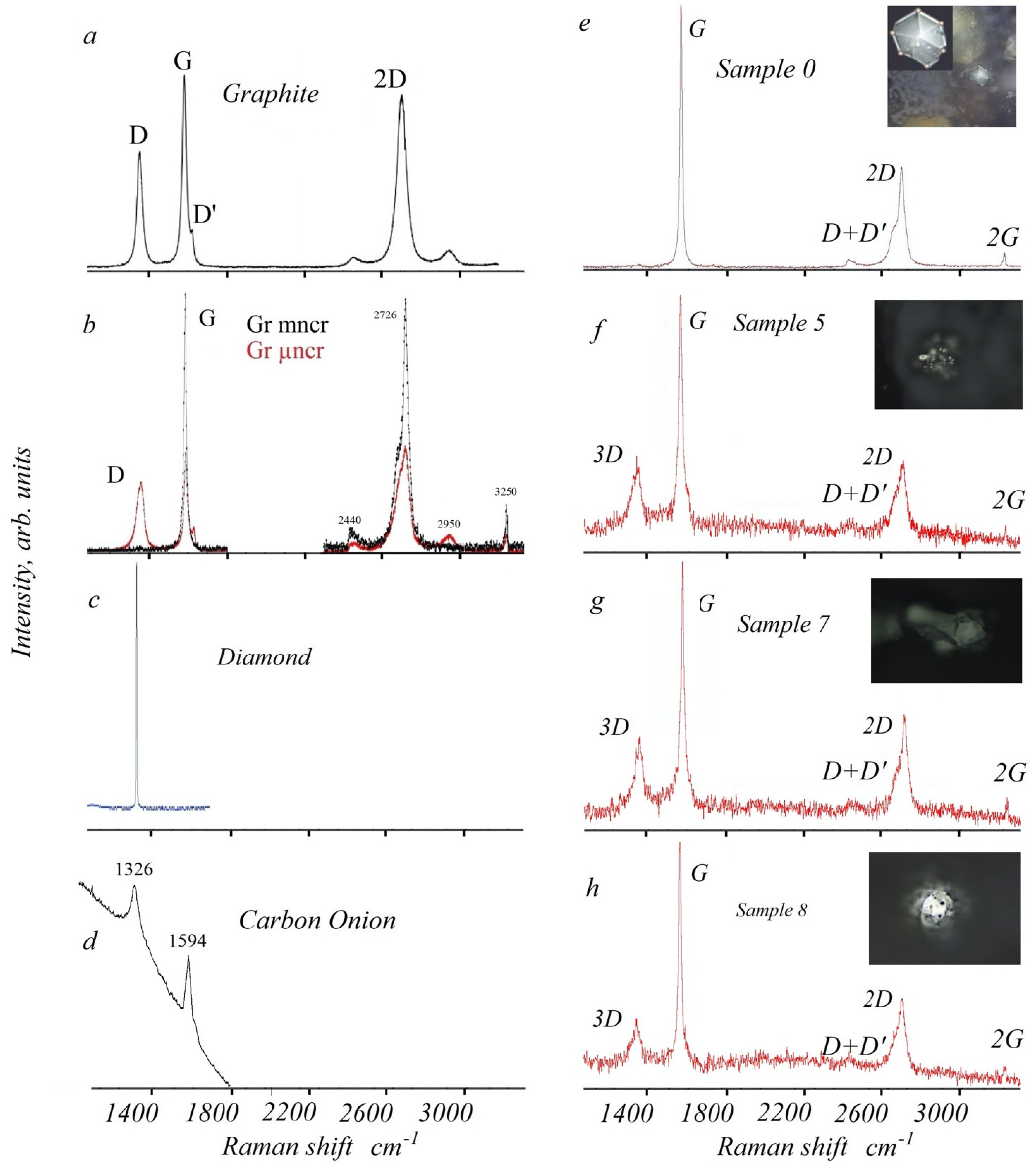Structure and Raman Spectra of Exotic Carbon Microcrystals from Meteoritic Dust of Chelyabinsk Superbolide
Abstract
1. Introduction
2. Preparation of Carbon Samples
3. Microscopy Images of Carbon Samples
4. Raman Spectra of Carbon Species
5. Discussion
6. Conclusions
Author Contributions
Funding
Data Availability Statement
Acknowledgments
Conflicts of Interest
References
- Chelyabinsk, Meteoritical Bulletin Database, The Meteoritical Society. Available online: http://www.lpi.usra.edu/meteor/metbull.php?code=57165 (accessed on 18 March 2013).
- Hughes, D.W. Meteorite falls and finds: Some statistics. Meteorities 1981, 16, 269–281. [Google Scholar] [CrossRef]
- Brownlee, D.E. Extraterrestrial components. In The Sea 7; Emiliani, C., Ed.; J. Wiley and Sons, Inc.: New York, NY, USA, 1981; pp. 733–762. [Google Scholar]
- Love, S.G.; Brownlee, D.E. A direct measurement of the terrestrial mass accretion rate of cosmic dust. Science 1993, 262, 550–553. [Google Scholar] [CrossRef] [PubMed]
- Blanchard, M.B.; Brownlee, D.E.; Bunch, T.E.; Hodge, P.W.; Kyte, F.T. Meteor Ablation Spheres from Deep-Sea Sediments; NASA Technical Memorandum; National Aeronautics and Space Administration, Ames Research Center: Washington, DC, USA, 1978; Volume 78510. [Google Scholar]
- Ganapathy, R.; Brownlee, D.E.; Hodge, P.W. Silicate spherules from deep-sea sediments: Confirmation of extraterrestrial origin. Science 1978, 201, 1119–1121. [Google Scholar] [CrossRef]
- Krinov, E.L. Über die Natur der Mikro-meteoriten. Chem. Erde 1959, 20, 28–35. [Google Scholar]
- Fredriksson, K.; Gowdy, R. Meteoritic debris from the Southern California desert. Geochim. Cosmochim. Acta 1963, 27, 241–243. [Google Scholar] [CrossRef]
- Marvin, U.B.; Einaudi, M.T. Black, magnetic spherules from Pleistocene and recent beach sands. Geochim. Cosmochim. Acta 1967, 31, 1871–1884. [Google Scholar] [CrossRef]
- Brownlee, D.E. Meteorite mining on the ocean floor. Lunar Planet Sci. 1979, 10, 157–158. [Google Scholar]
- Czajkowski, J.; Englert, P.; Bosellini, Z.A.; Ogg, J.G. Cobalt enriched hardgrounds—Newsources of ancient extraterrestrial materials. Meteoritics 1983, 18, 286–287. [Google Scholar]
- Jehanno, C.; Boclet, D.; Bonte, P.; Castellarin, A.; Rocchia, R. Identification of two populations of extraterrestrial particles in a Jurassic hardground of the Southern Alps. In Proceedings of the 18th Lunar and Planetary Science Conference, Houston, TX, USA, 16–20 March 1987; Lunar and Planetary Institute: Houston, TX, USA, 1988; pp. 623–630. [Google Scholar]
- Taylor, S.; Brownlee, D.E. Cosmic spherules in the geologic record. Meteoritics 1991, 26, 203–211. [Google Scholar] [CrossRef]
- Maurette, M.; Hammer, C.; Brownlee, D.E.; Reeh, N.; Thomsen, H.H. Placers of cosmic dust in the blue ice lakes of Greenland. Science 1986, 233, 869–872. [Google Scholar] [CrossRef]
- Hagen, E.H. Geochemical Studies of Neo-Gene till in the Transantarctic Mountains: Evidence for an Extraterrestrial Component. Master’s thesis, The Ohio State University, Columbus, OH, USA, 1988.
- Yiou, F.; Raisbeck, G.M. Cosmic spherules from Antarctic ice cores as proxy indicators of extraterrestrial matter influx during the last 150,000 years. In Workshop on Differences between Antarctic and Non-Antarctic Meteorites; LPI Technical Report 90-01; Lunar and Planetary Institute: Houston, TX, USA, 1900; pp. 99–100. [Google Scholar]
- Popova, O.P.; Jenniskens, P.; Emel’yanenko, V.; Kartashova, A.; Biryukov, E.; Khaibrakhmanov, S.; Shuvalov, V.; Rybnov, Y.; Dudorov, A.; Grokhovsky, V.I.; et al. Chelyabinsk airburst, damage assessment, meteorite recovery and characterization. Science 2013, 342, 1069–1073. [Google Scholar] [CrossRef] [PubMed]
- Taskaev, S.; Skokov, K.; Khovaylo, V.; Donner, W.; Faske, T.; Dudorov, A.; Gorkavyi, N.; Muratov, D.S.; Savosteenko, G.; Dyakonov, A.; et al. Exotic carbon microcrystals in meteoritic dust of the Chelyabinsk superbolide: Experimental investigations and theoretical scenarios of their formation. Eur. Phys. J. Plus 2022, 137, 562. [Google Scholar] [CrossRef]
- Avramov, P.V.; Fedorov, D.G.; Sorokin, P.B.; Chernozatonskii, L.A.; Gordon, M.S. Atomic and electronic structure of new hollow-based symmetric families of silicon nanoclusters. J. Phys. Chem. C 2007, 111, 18824–18830. [Google Scholar] [CrossRef]
- Avramov, P.V.; Chernozatonskii, L.A.; Gordon, M.S. Multiterminal Nanowire Junctions of Silicon: A Theoretical Prediction of Atomic Structure and Electronic Properties. Nano. Lett. 2007, 7, 2063–2067. [Google Scholar] [CrossRef][Green Version]
- Sheka, E.F.; Golubev, Y.e.A.; Popova, N.A. Graphene Domain Signature of Raman Spectra of sp2 Amorphous Carbons. Nanomaterials 2020, 10, 2021. [Google Scholar] [CrossRef] [PubMed]
- Kuzmany, H.; Pfeiffer, R.; Hulman, M.; Kramberger, C. Raman spectroscopy of fullerenes and fullerene–nanotube composites. Philos. Trans. R. Soc. Lond. A 2004, 362, 2375–2406. [Google Scholar] [CrossRef]
- Golubev, Y.A.; Rozhkova, N.N.; Kabachkov, E.N.; Shul’ga, Y.M.; Natkaniec-Hołderna, K.; Natkaniec, I.; Antonets, I.V.; Makeev, B.A.; Popova, N.A.; Popova, V.A.; et al. sp2 amorphous carbons in view of multianalytical consideration: Normal, expected and new. J. Non-Cryst. Solids 2019, 524, 119608. [Google Scholar] [CrossRef]
- Merlen, A.; Buijnsters, J.G.; Pardanaud, C. A Guide to and Review of the Use of Multiwavelength Raman Spectroscopy for Characterizing Defective Aromatic Carbon Solids: From Graphene to Amorphous Carbons. Coatings 2017, 7, 153. [Google Scholar] [CrossRef]
- Tuinstra, F.; Koenig, J.L. Raman spectrum of graphite. J. Chem. Phys. 1970, 53, 1126. [Google Scholar] [CrossRef]
- Selvan, R.; Unnikrishnan, R.; Ganapathy, S.; Pradeep, T. Macroscopic synthesis and characterization of giant fullerenes. Chem. Phys. Lett. 2000, 316, 205–210. [Google Scholar] [CrossRef]
- Bukalov, S.S.; Mikhlicyn, L.A.; Zubavichus, Y.V.; Leytes, L.A.; Novikov, Y.N. Study of structure of graphites and other sp2 carbonaceous materials using Raman scattering microspectroscopy and X-ray di ractometry. Ross. Khim. J. 2006, 50, 83–91. (In Russian) [Google Scholar]
- Golubev, Y.A.; Isaenko, S.I.; Prikhodko, A.S.; Borgardt, N.I.; Suvorova, E.I. Raman spectroscopic study of natural nanostructured carbon materials: Shungite vs. anthraxolite. Eur. J. Mineral. 2016, 28, 545–554. [Google Scholar] [CrossRef]
- Lobzova, R.V. Graphite and Alkaline Rocks of the Botogolsk Massif; Nauka: Moscow, Russia, 1975. (In Russian) [Google Scholar]
- Jorio, A.; Dresselhaus, M.S.; Saito, R.; Dresselhaus, G. Raman Spectroscopy in Graphene Related Systems; Wiley-VCH: Weinheim, Germany, 2011. [Google Scholar]
- Sheka, E.F. Spin Chemical Physics of Graphene; Pan Stanford: Singapore, 2018. [Google Scholar]
- Iijima, S. Direct observation of the tetrahedral bonding in graphitized carbon black by high resolution electron microscopy. J. Cryst. Growth 1980, 50, 675–683. [Google Scholar] [CrossRef]






| Sample No | 0 | 5 | 7 | 8 |
|---|---|---|---|---|
| Peak Name | ||||
| 3D | --- | 1365 cm−1 (100 cm−1) | 1365 cm−1 (100 cm−1) | 1364 cm−1 (100 cm−1) |
| G | 1582 cm−1 (120 cm−1) | 1590 cm−1 (110 cm−1) | 1585 cm−1 (110 cm−1) | 1582 cm−1 (100 cm−1) |
| D + D’ | 2446 cm−1 | 2450 cm−1 | 2439 cm−1 | 2450 cm−1 |
| 2D | 2719 cm−1 (120 cm−1) | 2738 cm−1 (120 cm−1) | 2722 cm−1 (150 cm−1) | 2729 cm−1 (150 cm−1) |
| 2G | 3250 cm−1 | 3250 cm−1 | 3250 cm−1 | 3250 cm−1 |
Disclaimer/Publisher’s Note: The statements, opinions and data contained in all publications are solely those of the individual author(s) and contributor(s) and not of MDPI and/or the editor(s). MDPI and/or the editor(s) disclaim responsibility for any injury to people or property resulting from any ideas, methods, instructions or products referred to in the content. |
© 2022 by the authors. Licensee MDPI, Basel, Switzerland. This article is an open access article distributed under the terms and conditions of the Creative Commons Attribution (CC BY) license (https://creativecommons.org/licenses/by/4.0/).
Share and Cite
Savosteenko, G.; Taskaev, S.; Avramov, P. Structure and Raman Spectra of Exotic Carbon Microcrystals from Meteoritic Dust of Chelyabinsk Superbolide. Nanomaterials 2023, 13, 73. https://doi.org/10.3390/nano13010073
Savosteenko G, Taskaev S, Avramov P. Structure and Raman Spectra of Exotic Carbon Microcrystals from Meteoritic Dust of Chelyabinsk Superbolide. Nanomaterials. 2023; 13(1):73. https://doi.org/10.3390/nano13010073
Chicago/Turabian StyleSavosteenko, Galina, Sergey Taskaev, and Pavel Avramov. 2023. "Structure and Raman Spectra of Exotic Carbon Microcrystals from Meteoritic Dust of Chelyabinsk Superbolide" Nanomaterials 13, no. 1: 73. https://doi.org/10.3390/nano13010073
APA StyleSavosteenko, G., Taskaev, S., & Avramov, P. (2023). Structure and Raman Spectra of Exotic Carbon Microcrystals from Meteoritic Dust of Chelyabinsk Superbolide. Nanomaterials, 13(1), 73. https://doi.org/10.3390/nano13010073






